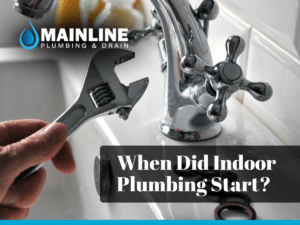When Did Indoor Plumbing Start?

Indoor plumbing is one of life’s unsung heroes; it exists silently, behind the scenes, and is sometimes overlooked until something goes wrong. Nonetheless, the impact of this foundational technology on our daily routines, health, and quality of life has been immeasurable. This portion of our infrastructure, as we know it today, has a fascinating history that is well worth delving into.
Plumbing is important for more than just convenience; it also affects health and sanitation, both of which are critical to human well-being. Imagine living without running water, sinks, or flushing toilets. Early innovations in this subject revolutionized urban growth and living circumstances, laying the groundwork for modern cities.
Early Civilizations and Water Systems
The ancient civilizations recognized the need for freshwater for survival. Around 4000-3000 BCE, the Indus Valley Civilization in what is now Pakistan and the Nile Valley in Egypt began to construct complex water supply and drainage systems. The Indus Valley’s intricate network of sewers and water refining facilities was a wonder of engineering, demonstrating unprecedented skill.
Similarly, the ancient Romans were known for their aqueducts and public baths, which used hydraulic engineering to transport water from afar to the center of their towns. This was the first large-scale implementation of centralized water distribution and indoor plumbing. Wastewater management was less advanced, with the Romans typically draining their drains into the nearest body of water, which also served as a drinking source.
The Greeks, while not known for their massive water systems, created some of the most significant early technological advances, such as the use of lead piping for water distribution. These ancient practices created the framework for the indoor plumbing we use today.
Middle Ages to Renaissance
The Middle Ages saw a significant decline in sanitary engineering in Europe, as the fall of the Roman Empire led to the abandonment of large towns and the complex aqueducts they relied on. It wasn’t until the Renaissance that interest in hygiene and engineering was reignited, leading to a resurrection of sorts for indoor plumbing.
In 1596, Sir John Harington, godson of Queen Elizabeth I, invented the first flush toilet, a precursor to the modern toilet. Harington’s toilet, the “Ajax,” was designed for the queen but wasn’t widely adopted due to its complexity and need for constant water flow. The idea, however, took root and would eventually blossom into the modern commode.
In 1602, an Englishman named Hugh Myddelton completed a scheme to provide fresh water to London by supplying water from the River Lea to a reservoir in the city, marking a rebirth of fresh water supply to urban areas.
Industrial Revolution and Modernization
The 19th century, especially the period of the Industrial Revolution, saw a burst of innovations in indoor plumbing. Cast iron and brass could be more readily produced and shaped, leading to the development of sturdy pipes. Better tools and work methods were also introduced, facilitating more complex plumbing installations.
Joseph Bramah developed the modern toilet design in the 1820s, building on Harington’s work. Alexander Cummings invented the S-trap in 1775 to keep unpleasant sewer gases out of a building. It is still used in toilets today. Simultaneously, William Feetham received a patent for the first modern shower in 1767, signaling a significant shift in bathing customs.
The 19th century also witnessed the invention of indoor taps and valves, making it possible for users to control the flow of water at their convenience, and the development of the modern sewer system, which separated stormwater from wastewater.
Impact on Health and Quality of Life
Indoor plumbing’s impact on public health is immeasurable. Before its widespread adoption, waterborne diseases were rampant in urban areas. Cholera, dysentery, and typhoid were common and often deadly. The implementation of indoor plumbing, sewage treatment plants, and clean water initiatives dramatically reduced the spread of these diseases, contributing to a drastic increase in life expectancy.
The Evolution of Indoor Plumbing Today
Indoor plumbing has advanced to a level of convenience and sophistication that our forefathers could not have imagined. High-tech materials, water-saving designs, and smart technologies have resulted in environmentally friendly and efficient solutions.
Greywater systems, for example, reuse water from sinks, showers, and washing machines for irrigation, reducing the amount of fresh water used. Smart plumbing, which combines sensors and internet connectivity, enables leak detection, real-time water monitoring, and even remote plumbing control using smartphone apps.
Final Thoughts
Indoor plumbing has evolved dramatically over time, from ancient Rome’s aqueducts to today’s smart houses. What began as a basic requirement for hydration and cleanliness has grown into a complex system that ensures comfort, safety, and ease.
The history of indoor plumbing is more than just the evolution of pipes and valves; it is a story of human ingenuity and our desire for better living circumstances. As we reflect on the history of indoor plumbing, we can’t help but appreciate its impact and look forward to further developments that will define the future.
Call Mainline Plumbing Now
If you have any plumbing needs, call Mainline Plumbing at (206) 741-0279 to schedule an appointment with one of our experienced technicians. Remember, keeping your indoor plumbing in top condition is essential for your health and quality of life. Let us help you maintain a safe and functional home!
